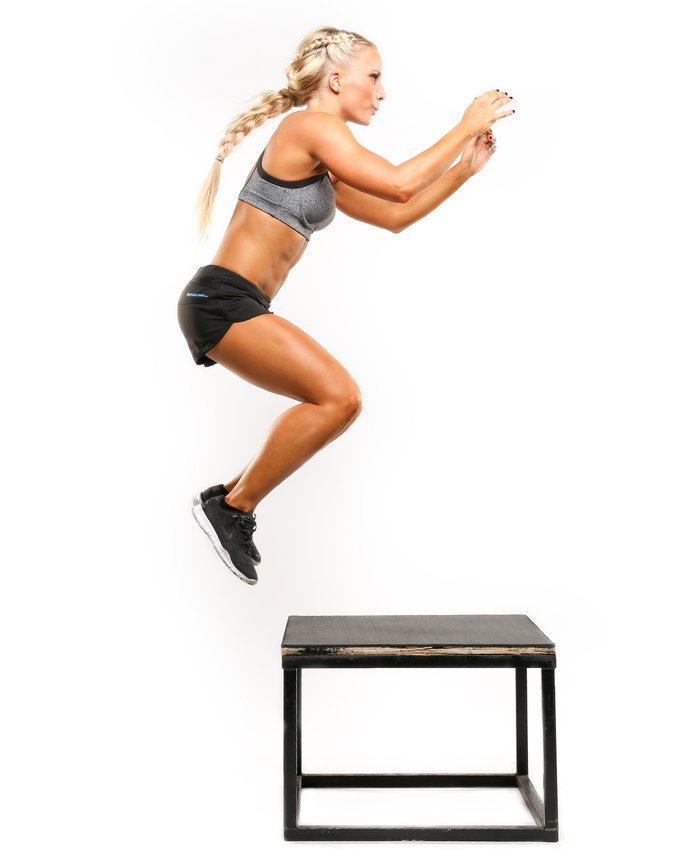When you look at your training schedule, it probably goes a little something like this: a day for legs, a few exercises to target bis and tris, a healthy heap of compound movements, some isolation work, and squats for days. Jumping isn't likely on the list. Sure, basketball and football athletes might have some plyometric jumps as a part of their practice, but the training usually ends there.
Incorporating bounce time isn't just for those players—learning to jump properly can complement any fitness effort, no matter what your activity. "Bringing at least some jump training into your normal routine can have advantages for strength, injury prevention, and intensity," says licensed physical therapist Brad Leavelle. Jumping is also mentally advantageous for both learning a new skill and overcoming hesitation (which many people have without knowing it).
Benefits of Bouncing
Structured jump training can help improve reactive strength, notes licensed physical therapist, Jeffery Yellin, CSCS. Reactive strength is essential for activities that involve a quick change in direction, like sprinting, football, or Olympic lifting. Reactive strength taps into the elastic qualities of your tendons, muscles, and ligaments for storing energy that’s used to push off the ground. For example, a runner who seems to be plodding along instead of showing a lighter, more efficient running form doesn’t have as much reactive strength.
Incorporating jumping into your routine in a way that yields the best results usually comes from plyometrics—exercises that cause muscles to exert maximum force in the shortest amount of time. Plyometrics shift muscle movement from relaxation to contraction rapidly, activating fast-twitch muscle fibers—a process crucial for building reactive strength. Another jump-dependent practice is Parkour. First developed as obstacle-based military training, Parkour adds other movements, like vaulting or rolling, but still relies on quick movement and fast recovery.

But jump training doesn't have to follow a specific set of moves like Parkour or plyometrics—you can throw in a few moves like jumping split squats, vertical jumps, or even jumping jacks into any strength or cardio routine.
Yellin notes that the mechanism of jumping has significant carryover into most movement patterns—from throwing a ball, to lifting a barbell, to sprinting down a track. Jumping utilizes the triple extension mechanism of the legs—the extension of the hips using the gluteal and hamstring muscles, the extension of the knees using the quads, and the extension of the ankles using the calf muscles—so jump training translates into everyday movement as well. Basically, through jumping, the body learns to operate more efficiently.
Learn to Land
For those who are ready to get jumping, Yellin suggests starting a plyometrics program by jumping up onto a sturdy, low box and then stepping down. Gradually, you can increase box height and, once your strength is built up, you can start jumping down as well. Why box jumps? As opposed to jumping rope or doing jumping jacks, box jumps are more explosive and require your core and leg muscles to contract in order to create force for the jump.

Learning how to land is just as important as understanding the power boost it takes to jump. After all, it's while landing that the majority of jump-related injuries occur. It's vital to come back down in a way that absorbs the force of the movement. "Landing needs to eccentrically load the muscles and not place too much stiff stress through the joints," says Yellin. This allows the muscles to lengthen, which slows the landing down in a controlled and balanced manner.
Your lower body might be your primary focus, but adding in arms can help. Swinging your arms provides momentum for the jump and stability when landing. If you're completely new to jump training, you can start with a low-intensity plyometric motion like jumping in place, jumping rope, or forward and backward hopping. From there, you can progress to box jumps.
Hop to It
As you're perfecting your jumping and landing techniques, it’s helpful to begin incorporating more squats into your routine as well.
The National Strength and Conditioning Association recommends that for performing high-level, lower-body plyometrics, you should be able to squat at least 1.5 times your body weight for one rep max.[1] Not only does this give you stronger leg muscles for pushing off for a jump, but a squat-based landing better absorbs the shock of impact. "Squats help to strengthen muscles like quads and glutes that need to be recruited for motions like box jumps," says Leavelle.

For most people, jump training is definitely worth a try. "Even throwing in some plyos before or after your workout can make a difference in terms of increasing your overall performance," Leavelle says. He suggests warming up with plyo-type exercises like jogging drills—think butt-kickers and high knee motions—as well as jumping lunges, or even skipping like a kid.
Jumping isn't for everyone, though. Yellin notes that athletes with a history of injury, muscle strains, previous knee surgeries, or spinal conditions need to exercise caution. For these athletes, the plyometric program should include no more than five low-to moderate-intensity exercises, and the total volume should be lower than that of a standard plyometric training program. Use extreme caution with single-leg exercises, and make sure to give yourself three to four days of recovery time between workouts.
References
- Haff, G. G., & Triplett, N. T. (Eds.). (2015). Essentials of Strength Training and Conditioning 4th Edition. Human kinetics.

